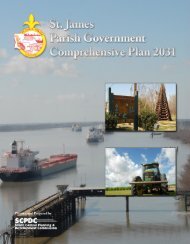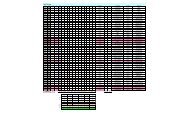City of Thibodaux Zoning Review - South Central Planning ...
City of Thibodaux Zoning Review - South Central Planning ...
City of Thibodaux Zoning Review - South Central Planning ...
Create successful ePaper yourself
Turn your PDF publications into a flip-book with our unique Google optimized e-Paper software.
2010 <strong>Thibodaux</strong> <strong>Zoning</strong> <strong>Review</strong>and attributes to discover spatial relationships between land uses.An example <strong>of</strong> this is identifying how many commercial propertiesare located within single-family style residences. Maps arethen generated to illustrate the findings. The results could indicatethat the neighborhood is actually in transition and a zoningchange is the best action.Nonconforming UsesA Nonconforming use means that the existing use is notauthorized for the zoning district in which it is located. Theconcept <strong>of</strong> nonconformities arises from adopting new codes forareas that already have some development. Such developmentis referred to as legal or “grandfathered” nonconforming uses.However, limitations may be imposed on nonconforming usesto discourage their continuation and to gradually bring all activitieswithin a given zoning district into compliance with the newstandard. Thus, it is typical to find a limiting clause in a zoningordinance that terminates a nonconforming use after the use isabandoned for a specified period <strong>of</strong> time. Several approachesto address this issue are listed below. While it is our strongestrecommendation for the city to take on a two step approach <strong>of</strong>a comprehensive plan and a comprehensive zoning update toaddress the zoning concerns, it is the political culture and landscapethat will make the ultimate decision.With regard to the <strong>City</strong> <strong>of</strong> <strong>Thibodaux</strong> <strong>Zoning</strong> Ordinance,Section 2200 “Grandfathering Provisions” for signs should probablybe removed to avoid confusion. Section 405’s prescriptiveperiod may be harder to enforce as monitoring activity andfrequency <strong>of</strong> use over 3 years can be difficult, in particular increating clearly documented information in advance <strong>of</strong> enforcementaction and most especially if no certificate <strong>of</strong> zoningcompliance was issued within three months <strong>of</strong> a change. The 18consecutive months is simpler for both the public to understandand for the city to establish a good record regarding activity. AlsoSection 405 allows that “destruction” <strong>of</strong> a structure is at 50% <strong>of</strong>its value. It is possible that if the city is considering making theordinance more lineate, it might want to increase the percentage<strong>of</strong> value.The decision to adjust the nonconforming clauses <strong>of</strong><strong>Thibodaux</strong>’s ordinance should be based upon how quickly thecity desires to move uses into conformity or how much leniencyit feels is necessary to keep a property in the market for reuse.It should be noted that without a more detailed zoning studythe council could possibly create a bigger problem by changingthe clause to be more restrictive or lenient. Many <strong>of</strong> the landuses in older neighborhoods could have actually changed sincethe zoning ordinance was adopted in 1979. It is conceivable thatthe zoning for those neighborhoods should be changed to fitthe current uses. If the grandfathering provisions were changedto become more restrictive, it has the potential to increase thenumber <strong>of</strong> vacant properties within several neighborhoods. Additionally,if the provisions were changed to become more lenient,it could leave residents without a tool to remove extremely egregioususes out <strong>of</strong> their communities.Nonconforming Use Short-term RecommendationsOption 1 More Restrictive Approach:If it is the council’s policy to eliminate nonconformitiesas soon as possible, then the approach taken by the <strong>City</strong><strong>of</strong> Hammond would accomplish this goal. In the <strong>City</strong> <strong>of</strong>Hammond, nonconforming uses lose their grandfather statusafter three months <strong>of</strong> consecutive non-use. This is the mostrestrictive time period <strong>of</strong> all comparable areas. However, theordinance does include an “Expanded Conditional Use” clausewhich originates with the zoning board and given final approvalby the city council. Owners <strong>of</strong> nonconforming properties leftvacant for more than three (3) consecutive months can requestan Expanded Conditional Use. This status is granted to theoriginal owner and cannot be transferred to a new owner. Theconditional use cannot depreciate the property values <strong>of</strong> neighboringproperties, it must protect and encourage “prosperity andgeneral welfare” <strong>of</strong> the community, and it cannot be a hazard inany way to the community in which it is located. The <strong>City</strong> <strong>of</strong>Hammond does permit a legally nonconforming use to incurdamages up to 75% <strong>of</strong> the fair market cost and still be restoredto its original nonconforming condition.While this approach will eradicate the city <strong>of</strong> the nonconforminguse, it would create a different problem. Again, it isdifficult to ascertain how many nonconforming uses actuallyexist within areas <strong>of</strong> concern without doing a detailed zoningstudy. The city has not updated its zoning since 1979 and hasnever done a zoning study on any <strong>of</strong> these areas. Many <strong>of</strong> theseneighborhoods may well be in transition and the nonconformitiescould actually outnumber the legal uses. This strict law hasthe potential <strong>of</strong> leaving numerous buildings abandoned and out<strong>of</strong> commerce. If this approach is the council’s desire, then againit is strongly recommended that a zoning study be conductedand possibly zoning changes recommended prior to enforcingsuch an ordinance.Option 2 Increase Damage Percentages and Length <strong>of</strong> VacancyTime:If it is the council’s desire to take a quick and uncomplicatedapproach, then increasing the percentage <strong>of</strong> allowable damageto nonconforming uses and extending the vacancy rule wouldfulfill that desire. Instead <strong>of</strong> only permitting damages to a structure<strong>of</strong> up to 50% <strong>of</strong> its value, the city might consider increasingthe percentage <strong>of</strong> assessed value (i.e. 60%, 70%, 75%, etc.), andincreasing the length <strong>of</strong> time a structure can remain vacant(i.e. 12 or 18 months) might be enough to quickly assuage theconcerns <strong>of</strong> the business community. This option can provideimmediate relief especially to those in the business community;however, it only superficially tackles the real problem. Nonconforminguses may still exist in large numbers. The egregiousness<strong>of</strong> the uses is uncertain. This option would allow for the extendedcontinuation <strong>of</strong> the nonconformities. If a truly <strong>of</strong>fensive use islocated near a residential neighborhood, this option would allowit to remain for some time.57






